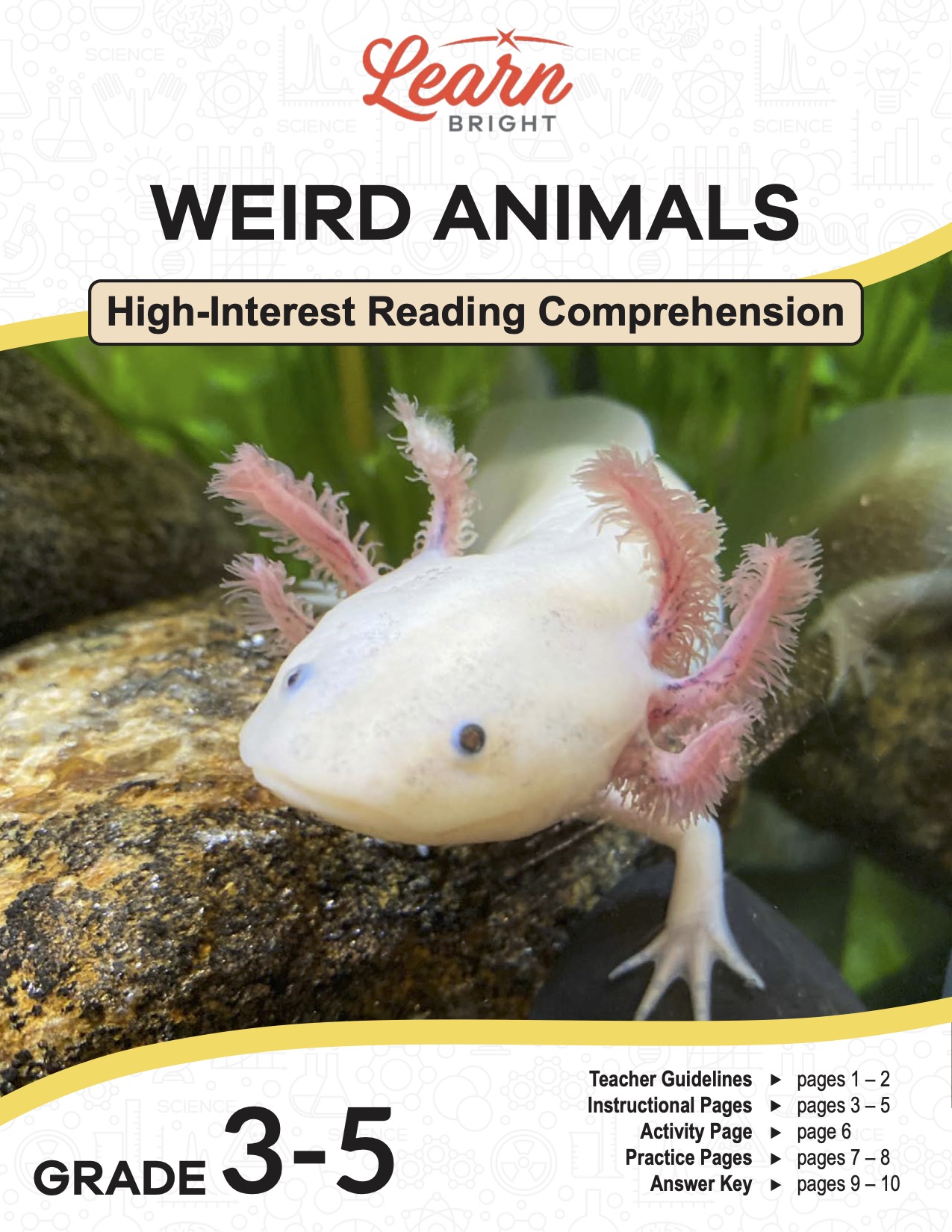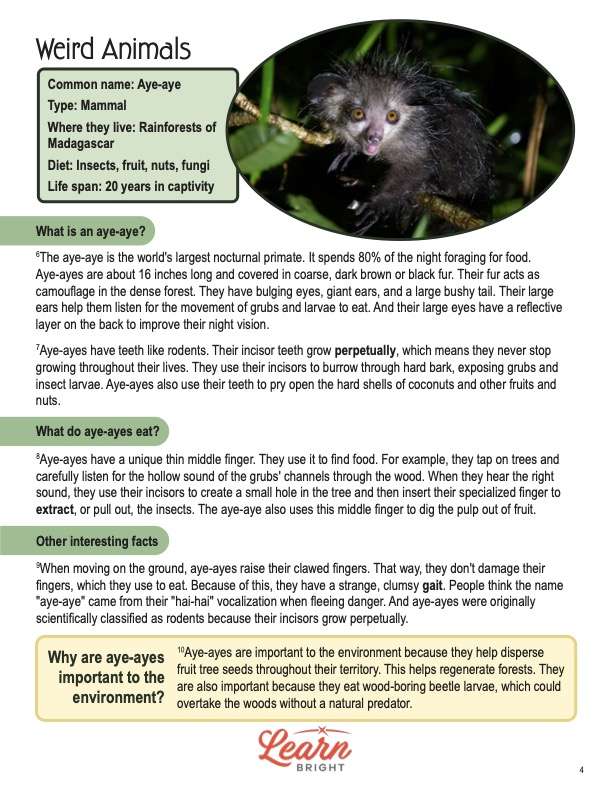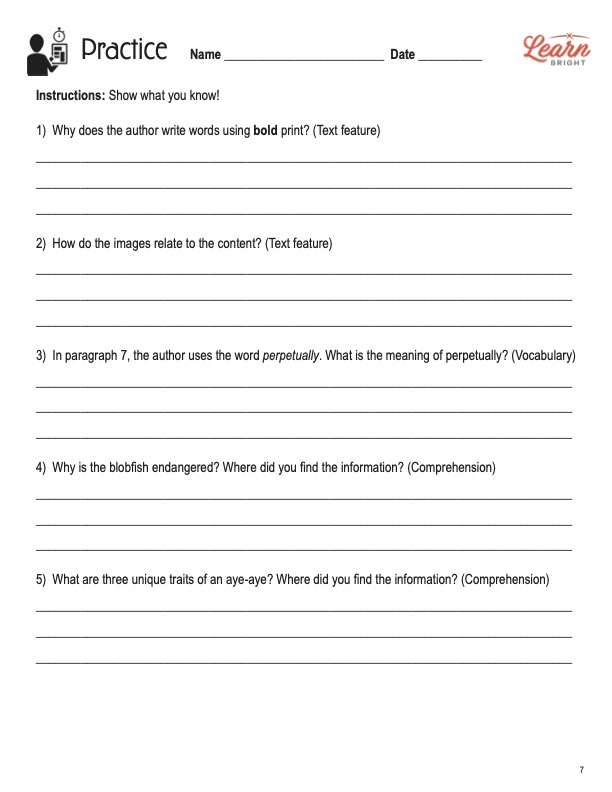Description
What our Weird Animals lesson plan includes
Lesson Objectives and Overview: Weird Animals is a high-interest reading comprehension lesson plan. As such, students will practice various close reading and comprehension skills. In addition, they will learn about the habitat, diet, and behaviors of axolotls, aye-ayes, and blobfish. This lesson is for students in 3rd grade, 4th grade, and 5th grade.
Classroom Procedure
Every lesson plan provides you with a classroom procedure page that outlines a step-by-step guide to follow. You do not have to follow the guide exactly. The guide helps you organize the lesson and details when to hand out worksheets. It also lists information in the yellow box that you might find useful. You will find the lesson objectives, state standards, and number of class sessions the lesson should take to complete in this area. In addition, it describes the supplies you will need as well as what and how you need to prepare beforehand.
Teacher Notes
The paragraph on this page gives you a little more information on the lesson overall and describes what you may want to focus your teaching on. It explains that you can teach this lesson in a whole-class setting or as an independent, small-group activity. The blank lines are available for you to write out any thoughts or ideas you have as you prepare.
WEIRD ANIMALS LESSON PLAN CONTENT PAGES
Axolotls
The Weird Animals lesson plan contains three content pages. Each one begins by providing a box of background information about the three weird animals the lesson discusses. The first is the axolotl, an amphibian that lives in Lake Xochimilco in Mexico. This carnivore lives between 10 and 15 years. Is it a lizard? Is it a fish? An axolotl is one of the most unique amphibians in the whole world. It is a type of salamander, but unlike other salamanders, axolotls spend their entire lives in the water. They are often referred to as Mexican walking fish.
Because of a rare condition called neoteny, the adult axolotl remains aquatic (in the water) and gilled instead of going through a normal amphibian cycle. As a result, the adults keep the features of tadpoles with feathery gills and long dorsal fins. Axolotls are carnivores. They primarily eat worms, insects, crustaceans, and small fish. Axolotls were at the top of the food chain in their environment for a long time. With the introduction of invasive species like perch and tilapia, they are no longer at the top.
Axolotls can regenerate almost any of their body parts. For example, if the leg of an axolotl is wounded or cut off, it will form a blood clot like a scab and regrow a new leg. Scientists have found they can do this up to five times. And scientists have also found that the axolotl can even regenerate part of its brain if it gets damaged! Sadly, axolotls are critically endangered, meaning their numbers are in sharp decline. There is a real threat that they may become extinct. But this only applies to wild axolotls. They thrive in captivity, so there are now more axolotls in captivity than in the wild.
Aye-Ayes
The next animal students will learn about is the aye-aye, an omnivorous mammal that lives in the rainforests of Madagascar. Its diet consists of insects, fruit, nuts, and fungi. Aye-ayes can live up to 20 years in captivity. The aye-aye is the world’s largest nocturnal primate. It spends 80% of the night foraging for food. Aye-ayes are about 16 inches long and covered in coarse, dark brown or black fur. Their fur acts as camouflage in the dense forest. They have bulging eyes, giant ears, and a large bushy tail. Their large ears help them listen for the movement of grubs and larvae to eat. And their large eyes have a reflective layer on the back to improve their night vision.
Aye-ayes have teeth like rodents. Their incisor teeth grow perpetually, which means they never stop growing throughout their lives. They use their incisors to burrow through hard bark, exposing grubs and insect larvae. Aye-ayes also use their teeth to pry open the hard shells of coconuts and other fruits and nuts. They have a unique thin middle finger that they use to find food. For example, they tap on trees and carefully listen for the hollow sound of the grubs’ channels through the wood. When they hear the right sound, they use their incisors to create a small hole in the tree and then insert their specialized finger to extract, or pull out, the insects. The aye-aye also uses this middle finger to dig the pulp out of fruit.
When moving on the ground, aye-ayes raise their clawed fingers. That way, they don’t damage their fingers, which they use to eat. Because of this, they have a strange, clumsy gait. People think the name “aye-aye” came from their “hai-hai” vocalization when fleeing danger. And aye-ayes were originally scientifically classified as rodents because their incisors grow perpetually. They are important to the environment because they help disperse fruit tree seeds throughout their territory. This helps regenerate forests. Aye-ayes are also important because they eat wood-boring beetle larvae, which could overtake the woods without a natural predator.
Blobfish
The last weird animal students will learn about is the blobfish, a peculiar fish that will eat almost anything it can find. Blobfish live in the Atlantic, Pacific, and Indian Oceans. Their life span is unknown, but there are some that have lived over 100 years. Outside of the water, blobfish can look quite strange. But they look much like regular fish in the ocean’s depths at 2,000 to 3,900 feet below. However, a blobfish is much different from your typical fish. It does not use a gas bladder as other fish do to create buoyancy. Buoyancy is the ability to float in a liquid. A blobfish can float like a balloon because it is made up of a gelatinous mass with a lower density than water. The blobfish also lacks any muscle!
Since blobfish remain almost—if not entirely—still, they have been called the sloth of the sea. Because of this, they are referred to as a lie-and-wait predator. This means the blobfish will hang around with its mouth open and wait until anything edible floats into its open jaws. Then they suck it in.
The blobfish has no predators. They live so far down in the ocean that the water pressure is too intense for most predators. So they can spend their entire life peacefully sitting on the sea floor. And humans don’t eat them either. Chefs don’t like to cook blobfish because they don’t have muscles and bones like other fish. Also, the gelatinous flesh isn’t easy to cook. But those who have eaten them say they taste like lobster.
Blobfish are an endangered species. Even though these fish lay thousands of eggs, only a few of their young survive to adulthood. This low survival rate, plus overfishing and deep-sea trawling, have caused the blobfish population to decline quickly. Nevertheless, blobfish are essential because they are a bottom feeder and help balance the plant matter and mollusk population.
WEIRD ANIMALS LESSON PLAN WORKSHEETS
The Weird Animals lesson plan includes two worksheets: an activity worksheet and a practice worksheet. Each one will help students solidify their grasp of the material they learned throughout the lesson. You can refer to the classroom procedure guidelines to know when to hand out each worksheet.
STRANGE ANIMALS ACTIVITY WORKSHEET
For the activity, students will research a strange animal of their own. They will draw a picture or paste an image of the animal in the box on the top of the worksheet page. Then they will fill in the information on the page, including a couple characteristics that make the animal so unique.
WEIRD ANIMALS PRACTICE WORKSHEET
The practice worksheet requires students to answer a series of 11 questions. These questions all relate to the content pages, so students will need to refer to them often for the answers. In addition, each question provides which reading tool the question corresponds to, such as text feature, vocabulary, or comprehension.
Worksheet Answer Keys
At the end of the lesson plan document is an answer key for the practice worksheet. The correct answers are all in red to make it easier for you to compare them with students’ responses. If you choose to administer the lesson pages to your students via PDF, you will need to save a new file that omits these pages. Otherwise, you can simply print out the applicable pages and keep these as reference for yourself when grading assignments.










